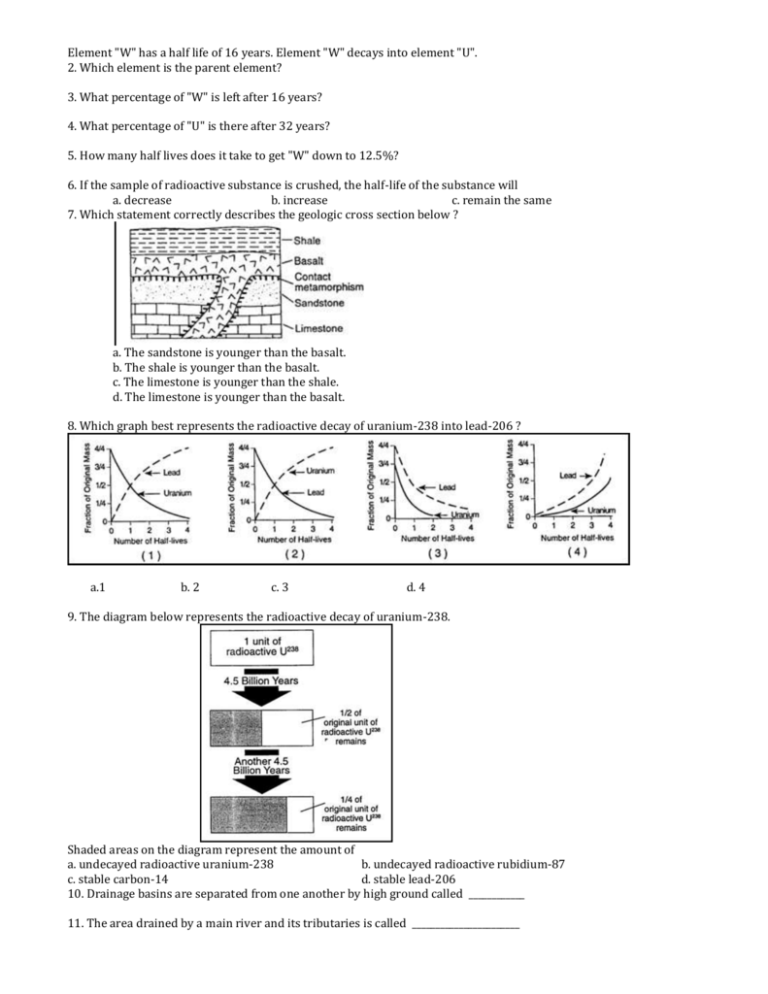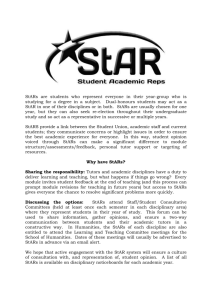a. The sandstone is younger than the basalt.
advertisement

Element "W" has a half life of 16 years. Element "W" decays into element "U". 2. Which element is the parent element? 3. What percentage of "W" is left after 16 years? 4. What percentage of "U" is there after 32 years? 5. How many half lives does it take to get "W" down to 12.5%? 6. If the sample of radioactive substance is crushed, the half-life of the substance will a. decrease b. increase c. remain the same 7. Which statement correctly describes the geologic cross section below ? a. The sandstone is younger than the basalt. b. The shale is younger than the basalt. c. The limestone is younger than the shale. d. The limestone is younger than the basalt. 8. Which graph best represents the radioactive decay of uranium-238 into lead-206 ? a.1 b. 2 c. 3 d. 4 9. The diagram below represents the radioactive decay of uranium-238. Shaded areas on the diagram represent the amount of a. undecayed radioactive uranium-238 b. undecayed radioactive rubidium-87 c. stable carbon-14 d. stable lead-206 10. Drainage basins are separated from one another by high ground called ____________ 11. The area drained by a main river and its tributaries is called _______________________ 12. A stream which contributes to a main river is called __________________ 13. Origin area of a river is called the _______________ 14. When the river’s water overflows its banks it is ____________________ 15. The area where a river enters a sea, lake or ocean is called ___________________ 16. The steeper a river's slope the ________ its speed will be. 17. The faster a river's water is going the _______the pieces of sediment it can carry. 18. A broad looping bend in a river is called a ________________________ 19. The shallowest part of a river is where the water is going the __________________ 20. Deposition occurs where the river's water is going the _____________________ 21. The fastest part of a river when it is curved is the ____________________ 22. The fastest part of a river when it is going straight is the ____________________ 23. The oldest rock unit at location (as shown on the diagram below) 28. Fossils are normally only found in ________ rocks ? 29. The process of breaking down rocks at or near the earth's surface is called ________________ 30. What happens to the amount of surface area as it is weathered ? __________________ 31. The 3 factors that control the rate of weathering are ______________________________________________________________________ 32. Is the rate of decomposition is aided by disintegration. ______________________________ 33. A rounded rock means that it has been weathered by _______________________________ 34. A mineral with a hardness of more than 7 will not have a streak. _______________________________ 35. What is the surface area of a cube that is 3 cm long, 3 cm wide and 3 cm tall ? ____________________ 36. Carbonic acid and limestone can form _______________ 37. How many types of weathering are there ? ___________________ 41. What is the name of the process by which water carries materials from the upper soil horizons down to lower soil horizons ? ____________________ 42. Organic matter from more or less decayed plants and animals is called ____________________ 43. A poorly developed soil is called ____________________ 44. The A horizon of a soil profile is called the Zone of ____________________ 45. The B horizon of a soil profile is called Zone of ____________________ 46. Humus is the primary source of ______ in soil. 55. Rocks that allow water to pass through them must be ____________________ 56. When there is little rain the water table can ____________________ 57. A(n) ___________is formed when the water table is exposed at the surface in permeable rock. 58. How many stars are in a galaxy ? ____________________ 59. The stars that are further from the center of a galaxy have a ______orbital speed than those closer in. 60. Approximately 90% of the visible universe’s mass is composed of ____________________ 61. Into which group do most stars fall ? ____________________ 62. ____________________is the North Star. 63. Are red stars are hotter than blue stars. ____________________ 64. A light-year is a unit of ____________________ 68—71. List the following in the correct sequence of a star’s life cycle. ____________________ a. white dwarf b. red giant c. main sequence d. nebula 65. The fact that the spectra of stars are shifted towards the red suggests that the stars are____________________ 66. After our star, the next closest star to earth is approximately 12 billion light-years away. ____________________ 67. Stars seem to change position during the night due to the____________________ 72. A nebula becomes a star when Answer the next 2 questions using the following charts: 78. How much brighter is the sun than Sirius ? _________________ Using the H-R Diagram below, answer the following 4 questions: 79. Supergiants have low temperature and absolute magnitudes 80. In general, blue star are the biggest stars. _________________ The diagram below is a contour map. Between which two points is the slope of the hill the gentlest ? ____________ 81. What is the elevation of the highest contour line shown on the map below ? _________________ 82. What does the spacing of contour lines on an area of a map tell you about the topography of that area ? _________________ 83. The contour lines on the map below show elevations above sea level, measured in feet. What is the highest possible elevation represented on this map ? _________________ 84. How much change in elevation is there between the school at point A and the house at point B ? ____ 85. There is a severe storm brewing in the south and tides are expected to rise 30 feet. How many buildings will have water in them due to high tide ? _________________ Base your answers to the next 2 questions on the map below. 86. Which diagram best represents the profile along a straight line between points C and J ? 87. In the map above, what general direction does Tenaya Stream Flow ?____________________________ 88. As one moves away from the mid-atlantic ridge the rocks get____________________________ 89. According to Wegener, this was the first continent. ____________________________ 90. If the theory of sea-floor spreading was correct, we would expect to find______________ running down the middle of the Atlantic Ocean floor 91. The continents of ________________________________________seem to fit together like pieces of a puzzle and first gave rise to the idea of drifting continents. 92. The scientist who first put forth the theory of continental drift was____________________________ 93. The average rate of sea-floor spreading is about ____________________________ 94. Rigid blocks of crust and the upper part of the upper mantle are called____________________________ 95. Crustal material is created at a _____________________boundary. 96. Movement along large breaks in plates is called a____________________________ 97. The . of an earthquake is located on the earth's surface. Use the table below to answer the following 3 questions. 98. How far can S-waves travel in 6 minutes ? ____________________________ 99. If the P-wave from an earthquake arrives 4 minutes and 30 seconds before the S-wave, how far away is the earthquake ? ____________________________ 100. If the P-wave arrives 8 minutes after an earthquake occurs, how far away is the epicenter? ____________________________








